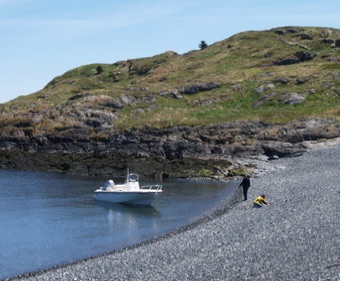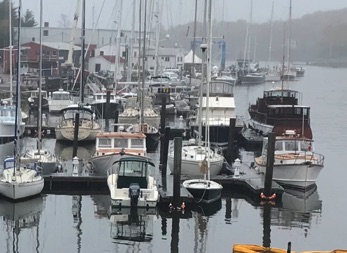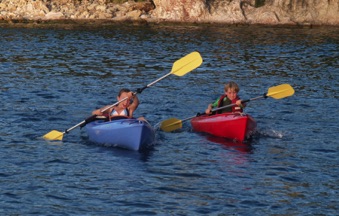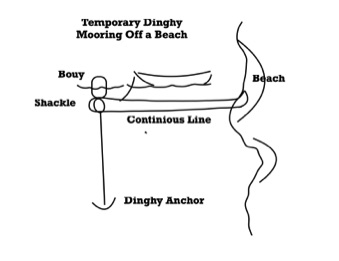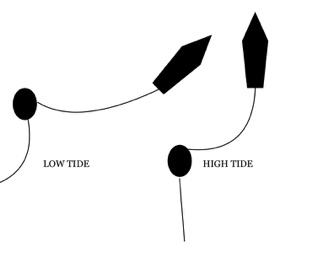What to Watchout for
While Cruising Maine's Coast
Story and photos by David H. Lyman
This article appwared in the March 2021 edition of Cruising World magazine
There are a few navigational challenges I should mention, such as fog, 10-foot tides, 4-knot currents, anchoring among rocks and ledges, and lobster buoys and trap lines. Did I say cruising the coast of Maine was going to easy, but it can be an exciting challenge for any cruising sailor. I can think if no better place to test your skills while exploring one of the world’s great archipelagos.
Dinghy Beaching
Quick aside on dinghies: Finding a place along these islands to beach a dinghy is one thing; securing said dinghy is another. Pull it up on the beach, and when you get back from your hike, you might find that the tide has floated it off the beach and it’s drifting away, or it’s high and dry, 30 feet from the water’s edge.
There are numerous techniques to solve this problem. The captain can drop off the landing party and return to the yacht for a nap. Go ashore in kayaks; they are easily pulled above the high-tide line and carried back. Or rig a dinghy-retrieval mooring system: Secure a floating buoy to the dinghy anchor line with a shackle. Drop it in deep water. Nose into the beach, off-load, then with a long loop of line rove through a shackle on the anchor float, pull the dinghy back out to where you dropped the anchor. Tie the shore end of the loop to something above high tide. When you get back, just pull your dinghy in to the beach. Make your own, or try West Marine’s Anchor Buddy, a readymade dinghy mooring system using a long bungee cord that snaps your dinghy back out into deep water.
Fog: There are three degrees of fog, I’m told. With “normal” fog, you can see a quarter-mile ahead. “Thick” fog is when you can see only a few boat lengths ahead. With “dungeons” of fog, it’s so thick, you can’t see the bow of your own boat. In the old days, Mainers practiced potato navigation: a kid on the bow with a bag of spuds tossing them ahead. A splash? Keep going. A thud? Tacking!
Today, AIS, radar, GPS, chart plotters and VHF have reduced the anxiety, but many lobster boats fail to use AIS, radar doesn’t see trap buoys and lines, and the currents haven’t changed. Someone on deck needs to keep visual watch while you are below glued to the radar screen. The sounder doesn’t help much in fog. Your keel could be in 30 feet of water with the bowsprit tangled up in the spruce trees ashore. The most valuable piece of equipment to have on board in fog is the anchor. Fog will burn off by late morning—if it’s going to. In June and early July, fog is more common, less so later in the summer. September is the best month in Maine.
Tides and current: Tides in Maine run 8 to 10 feet. That’s a lot of water to push up into the bays and drain back out, twice each day, at six- and 12-hour intervals. The tidal current running in and out of bays and coves can reach 4 knots. An hour’s run across the bay can set you off a mile on arrival, unless you compensate. With all those ledges and rocks lurking about, even a few feet off course can put you aground.
Anchoring means deploying sufficient scope to cope with the tidal range. Then there’s the set of the current: When the tidal current switches direction, where will your boat sit? Best to have a few anchors and extra line aboard to deploy in a Bahamian moor, to anchor astern or to run a stern line ashore.
Lobster buoys and trap lines: Lobster buoys are as much a hazard as fog and currents. Maine is prime lobster-fishing territory, with buoys so thick in places, you could walk to shore on them. The colorful buoys are not the problem—it’s the line that floats just below the surface from the buoy to the toggle. The toggle is a small float that keeps the trap line off the bottom, but when the tide is low, the toggle might reach the surface, and the 20 feet of line to the colorful buoy floats just below the surface.
Steer around the top of a buoy, not the bottom end where the line exits the base of the buoy. Do not go between the buoy and the toggle; you’re liable to find that you’ve snagged the line and fouled the prop. This might require a dive overboard into frigid water to cut the line free. And in most places, the sea rarely gets above 60 degrees, even in the middle of the summer. Lobster boats have a wire cage around the prop to keep out their trap lines. You can have a line cutter bolted to your prop shaft to cut the line, but then the fisherman has lost his trap. Radar doesn’t see the buoys, and you can’t see them at night. Keep a constant watch when navigating in Maine, and steer clear of buoys and trap lines. Even sailboats with their prop locked can snag a line on the blades or the rudder. Divers can be hired in many harbors to free a fouled prop. Still, lobster buoys are helpful in seeing which way the current flows and at what speed.
Prevailing winds: A midsummer day in Maine is apt to be under a high-pressure system, resulting in sunny, fog-free days but little wind, especially in the mornings. As the land heats up, a southwest sea breeze is likely to fill in after lunch, and might get up to 20 knots by late afternoon, just before dying off before dark. Gales are infrequent in the summer, and when a low comes up the East Coast, it tends to pass by just offshore to the east, producing northeasterly winds. Most Maine bays and harbors are open to the southwest, providing a lee to those winds. Hurricanes are infrequent. ■
Should you run aground, or in the case above, haul up on a ledge, one technique to attempt is to convience the crew they needs to climb out on the boom to tip the boat so it just might float free.


